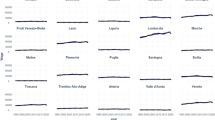Abstract
Most empirical studies of the U.S. wage-price relationship in the pre-fuel crisis period found wages systematically lagging prices, even in the long run. This finding was considered to be problematical or disturbing since it contradicts standard expectations generated by the competition model. It is here hypothesized that the empirical findings are affected by compositional-aggregation bias. This hypothesis is tested (and supported) by applying a standard (Phillips-Curve) wage equation to a regionally disaggregated body of data using individual SMSA observations.
Similar content being viewed by others
References
Archibald, G. “The Structure of Excess Demand for Labor.” In E. Phelps (ed.),Micro-Economic Foundations of Employment and Inflation Theory. 1970.
Barret, N. “Quarterly Price and Wage Behavior in U.S. Manufacturing.”Quarterly Journal of Economics (August 1974).
Berg, S. and Dalton, T. “Sectoral Employment and Shifts in the Aggregate Phillips Curve.”Southern Economic Journal (1975).
W. G. Bowen and P. A. Berry, “Unemployment Conditions and Movements of the Money Wage Level.”Review of Economics and Statistics, Vol. XLV (May 1963), pp. 163–172.
Frisch, H., “Inflation Theory 1963–1975: A ‘Second Generation’ Survey,”Journal of Economic Literature (December 1977), pp. 1289–1317.
Gordon, R.“Dynamic Considerations in the Choice of Inflation and Unemployment Targets — A Comment.” In K. Brunner and A. Meltzer (eds.),The Phillips Curve and Labor Markets. 1976.
Hall, R.“The Phillips Curve and Macroeconomic Policy.” In K. Brunner and A. Meltzer (eds.),The Phillips Curve and Labor Markets. 1976.
Izraeli, O. “Differentials in Nominal Wages and Prices Between Cities.”Urban Studies (October 1976).
Izraeli, O. and Kellman, M. “Changes in Money Wages Rates and Unemployment in Local Labor Markets: The Latest Evidence.”Journal of Regional Science (1979).
Johnston, J.Econometric Methods. Second Edition, 1970.
Laidler, D. and Parker, “Inflation — A Survey.”Economic Journal (December 1975).
Lucas, R. “Econometric Policy Evaluation: A Critique.” In K. Brunner and A. Meltzer (eds.),The Phillips Curve and Labor Markets. 1976.
Lucas, R. and Rapping, L. “Real Wages, Employment and Inflation.”Journal of Political Economy (June 1969).
Perry, G. “Changing Labor Markets and Inflation.”Brookings Papers on Economic Activity 3 (1970).
Rees, A. “Labor Economics: Effects of More Knowledge ‘Information Networks in Labor Markets.’”A. E. R. Papers and Proceedings. 1966, pp. 559–566.
Rees, A. and Hamilton, M. “The Wage-Price-Productivity Perplex.”Journal of Political Economy (February 1967).
Rowley, F. and Wilton, D. “Quarterly Models of Wage Determination: Some New Efficient Estimates.”The American Economic Review (June 1973).
Santomero, A., and Seater, J., “The Inflation Unemployment Tradeoff: A Critique of the Literature.”Journal of Economic Literature. June 1978, pp. 499–544.
Solow, R. and Samuelson, P. “Analytical Aspects of AntiInflation Policy.” In Smith and Tiegen (eds.),Money. National Income and Stabilization Policy. 1971.
Turnovsky, S. “The Expectations Hypothesis and the Aggregate Wage Equation: Some Empirical Evidence for Canada.”Economica (1972): 1–17.
Thomas, R. “The Cross-Sectional Phillips Curve.” Manchester School of Economics and Social Sciences, September 1974.
Author information
Authors and Affiliations
Rights and permissions
About this article
Cite this article
Izraeli, O., Kellman, M. The “rationality” hypothesis and the spatially disaggregated U.S. labor market. Ann Reg Sci 14, 39–50 (1980). https://doi.org/10.1007/BF01284202
Issue Date:
DOI: https://doi.org/10.1007/BF01284202




